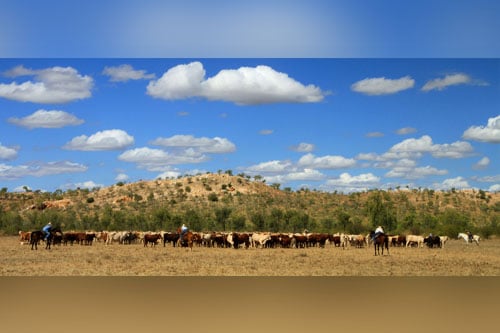
Ross Sticklen is HR manager of Australian beef producer Stanbroke, which operates eight cattle stations in northern Queensland

by Sarah Morgan
“Not everyone wants to work in the city,” said Ross Sticklen, which is just as well because his job is to recruit staff for cattle stations in some of the most remote areas to be found throughout the outback in Northern Queensland.
Sticklen is the HR manager of Australian beef producer Stanbroke which operates eight cattle stations in northern Queensland covering some 1.6 million hectares. The company also manages 46 properties in southern Queensland.
“There is no one type of person who is attracted to working on cattle stations,” said Sticklen, who has worked at Stanbroke since 2005.
“Those drawn to agriculture can come from diverse backgrounds. We attract Ag. College graduates, tradesmen and those off family properties wanting to develop a career in agriculture, to name a few.
“It’s more than horse work these days; a wide range of skills are required to work on a cattle station.”
Sticklen said Stanbroke rely a lot on two wheel bikes and side-by-sides which they found much safer for their staff to operate.
“Everyone has some skill base and we like to develop and enhance their existing skills to a level that makes them feel confident to deal with or undertake any job assigned to them on one of our stations,” he said.
“We rate a good attitude as being essential; if you have that and get involved in what the company does you will have a great career in the industry.
“That said, when filling positions, we are upfront with people because we know it won’t suit everyone. The postings are remote and you will be hours from the nearest town.”
And it is this remoteness which is one of the toughest challenges facing some cattle properties competing for staff among what are usually small local populations and in Northern Queensland.
.jpg)
This has been compounded in the past by the mining sector which is also competing for staff from the same small pool of locals.
Data from the Australian Bureau of Statistics shows that in Cloncurry for example, the nearest regional centre to four of Stanbroke’s cattle farms in northern Queensland, a full 10.8% of the population is in agriculture with metal ore mining the only industry to engage more of the population than farming at 21.3%.
“It is harder to attract people when the mining industry is booming,” Sticklen said. “Mining is one of the biggest employers in remote Queensland and no industry can compete with the salaries they offer during boom times.
“But boom times don’t last as we have seen time and again and that’s where some people prefer the stability of ongoing, well-paid work at a company like Stanbroke.
“Stanbroke has the ability to offer experience in a wide range of skills and being a family owned integrated supply chain I believe is helping attract people back from mining.”
Sticklen was quick to point out that money was not the only driver for many people, with some preferring the quitter pace of life on the land.
“For some it’s about being on the land, away from the city and crowds of people and noise,” he said. “It suits some people and not others because it is much more than just a job; it is a way of lifestyle and developing skills. “
.jpg)
Sticklen, who comes from a grazier background and has 42 years’ experience in the cattle industry, said the variety of jobs available with Stanbroke often included jillaroos and jackaroos, machinery operators, grader drivers and positions at the feedlot and meat processing.
Stanbroke also identify staff showing a desire to progress into more senior rolls within the company, giving them additional responsibility, training and exposure to keep staff retention at high levels.
While cattle stations themselves are quite remote, Sticklen said the facilities offered at some these days are much more than most would expect including wi-fi, recreational clubs, comfortable accommodation and meals provided.
And surprisingly, cattle stations – while located in some of the most isolated areas of Australia – are doing their best to reach gender parity with women accounting for around 42% of the staff Stanbroke employ on their cattle stations.
“We are hoping to get that to 50-50,” Sticklen said. “It has been a male dominated industry in the past but we get a lot of women apply for positions and find they make great employees because they have great attention to detail, they are good with the equipment and the livestock and they are resilient.
“While we hope to achieve gender parity, our focus will remain on the quality of staff we have because we understand that helps us to produce quality beef which is what we are all about.”
Sarah Morgan is a freelance writer, journalist and corporate communications specialist. She is the founder of Core Communication Group.